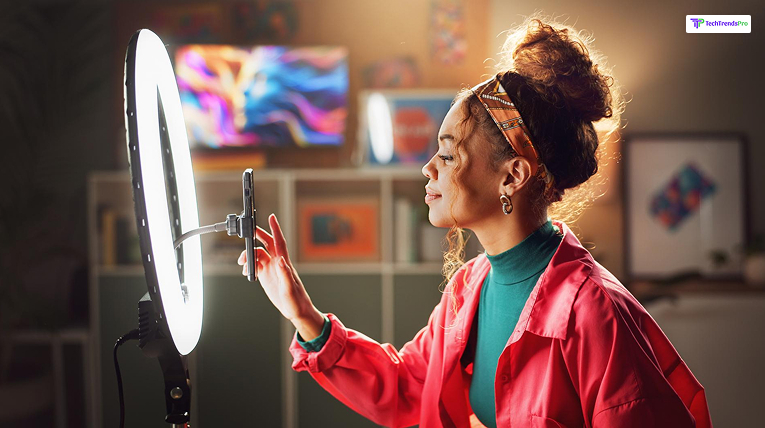
With algorithms, automation, and digital intelligence playing increasingly dominant roles globally, a new type of celebrity has arisen: the AI influencer.
Where they were once a novelty and niche interest, AI-generated influencers now rapidly fill positions as mainstream faces of social media advertising and digital culture.
From digitally created fashion models to artificial intelligence celebrity endorsers, these influencers walk the tightrope of man and machine, fantasy and the real world.
They are accompanied by equal wonder and moral panic as they redefine the influence maps, authenticity, and online self.
Here are all the things that you would like to know about AI influencers:
- What are they
- How they’re created
- Their role in marketing
- Cultural and psychological implications
- Criticisms and controversies
- Future trends
What Is An AI Influencer?
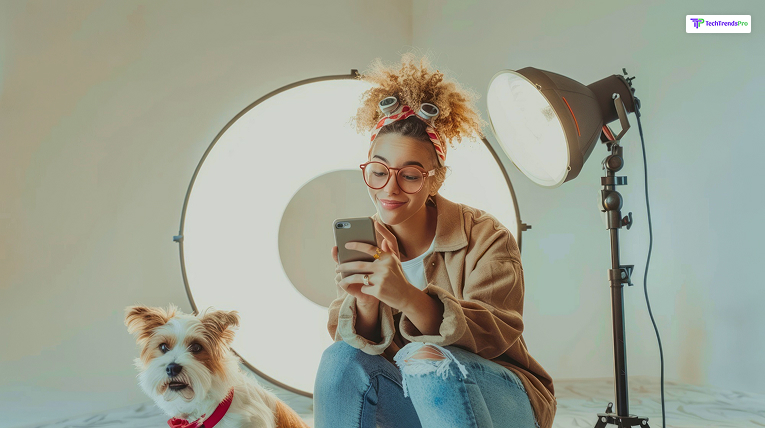
AI influencers, virtual influencers, or synthetic influencers are computer-created and artificial intelligence characters.
They are purely virtual but may possess real human-like faces and personalities. AI influencers can post, interact with their followers, endorse products, and even collaborate with brands, just like ordinary human influencers.
They range from AI robots that operate independently to those operated by teams of human creators with the assistance of AI-based behavior and appearance.
Key Features:
- Appear human or stylized (cartoon-like or hyperreal)
- Based on platforms like Instagram, TikTok, or YouTube
- Operate on AI, machine learning, CGI, and sometimes motion capture
- Possess backstories, personalities, values, and opinions
- Typically created and maintained by media or tech companies
Examples Of Known AI Influencers
Here are a few good examples of all the known AI Influencers that you should know about.
1. Lil Miquela (@lilmiquela)
- The world’s best-known AI influencer
- Developed by the LA company Brud
- Depicted as 19-year-old robot, being Brazilian-American
- Touched on Prada’s, Calvin Klein’s, runways as well as been seen on the screen via music videos
2. Imma (@imma.gram)
- Japan’s very first pink bob hairstyle virtual model
- Designed by Tokyo company Aww Inc.
- Worked with international brands IKEA, Nike, and others
3. Shudu (@shudu.gram)
- Launched as the “world’s first digital supermodel”
- Created by photographer Cameron-James Wilson
- Caused controversy regarding digital representation and cultural appropriation
4. Bermuda, Blawko, Kyra, Noonoouri, Lu do Magalu
- Other AI personalities with unique styles and fans
These influencers all have millions of followers, secure sponsorship deals, and even create music, artwork, or educational content.
How To Create AI Influencers?
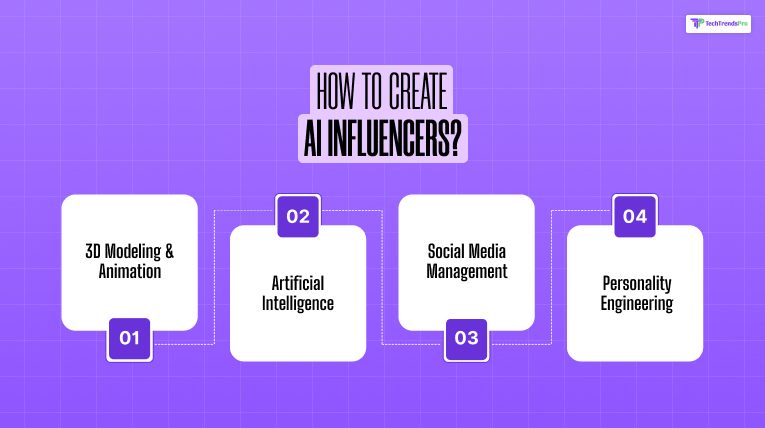
Creating an AI influencer involves the mix of advanced AI, 3D modeling software, and creative storytelling:
A. 3D Modeling & Animation
- Models and animation of the characters are done using tools like Blender, Unreal Engine, or Maya.
- Artists design facial expressions, gestures, and movements in a natural manner.
B. Artificial Intelligence
- AI is used for captions, replies to chat, and content strategy.
- Natural language processing (NLP) is utilized by a few platforms to mimic dialogue.
- Deep models can analyze patterns and automate action.
C. Social Media Management
- Like human influencers, AI avatars post periodically, respond, and advertise.
- Digital marketers get together and talk to the crowds normally.
D. Personality Engineering
- AI influencers possess individualized “personas” for branding purposes as given by the creators.
- Backstory, belief, and preference are built to enable identification and unity.
Why Are AI Influencers So Popular?
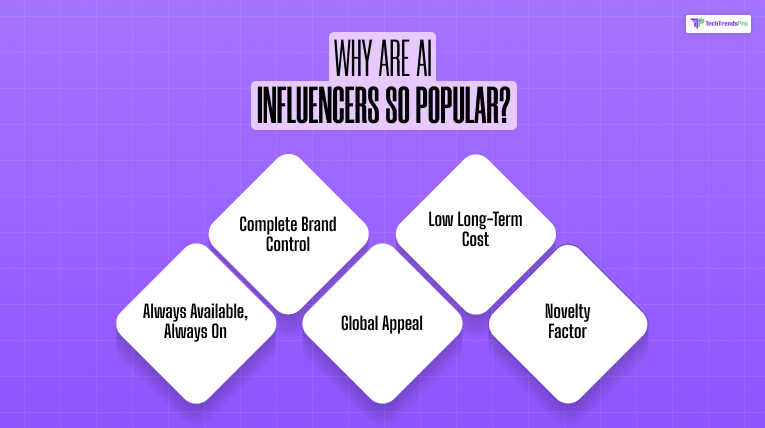
It has been seen that AI Influencers are becoming very popular day by day, but what is the reason for this to happen? Let’s check it out.
1. Always Available, Always On
AI influencers never get tired, sick, or go dark like their human equivalents. They can post at any time, and they are beautifully edited.
2. Complete Brand Control
Brands have the freedom of fully scripting an AI influencer’s message, look, and attitude, reducing the risk of PR disasters or surprises.
3. Global Appeal
They can be pitched to fit any geography, language, or cultural quirk, making them universally affordable.
4. Low Long-Term Cost
Though expensive to make, AI influencers have no salaries, accommodation, or travel costs in the long run.
5. Novelty Factor
Fans are curious and interested in the union of the real and artificial.
AI Influencers In Marketing And Business
The influencer marketing market is worth over $21 billion (as of 2024), and AI influencers are capturing an ever-larger portion of that.
How Brands Utilize AI Influencers:
- Product endorsements: Cosmetics, fashion, technology, and gaming
- Brand ambassadors: Promoting values like innovation or sustainability
- Customer interaction: Chatbots introduced in the form of an influencer
- Virtual campaigns: Completely digital ad campaigns with no human touch
Benefits to Brands:
- Message consistency and reliability
- Very high creative freedom (no physical limitations)
- Appealing to youth, technology-savvy consumers
Real-Life Examples:
- Calvin Klein: Collaborated with Lil Miquela for a campaign
- Prada: Employed virtual models in Milan Fashion Week commercials
- IKEA Japan: Collaborated with Imma for smart home furniture promotional designs
Ethical Concerns And Controversies
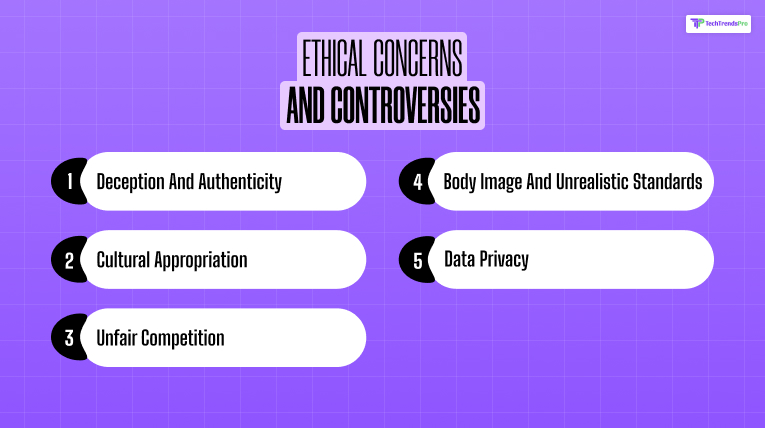
Even if the hype is thrilling, AI influencers introduce several ethical and societal issues:
A. Deception And Authenticity
- Do consumers realize that they are talking with an AI?
- Should one emulate emotions or feelings that the AI naturally cannot have?
B. Cultural Appropriation
- Some AI influencers are criticized for copying the style or identity of non-majoritarian populations without actual representation.
C. Unfair Competition
- Human influencers lose money, whereas AI influencers, backed by big technology companies, have unlimited marketing potential.
D. Body Image And Unrealistic Standards
- Perfect computer bodies will worsen body dysmorphia and self-esteem disorders in general, and particularly for young people.
E. Data Privacy
- If AI influencers interact with users, do they harvest and use that data reasonably?
These issues mandate that creators, brands, and platforms implement transparency disclosure policies, human standards of decency, and moderation.
Legal And Regulatory Landscape
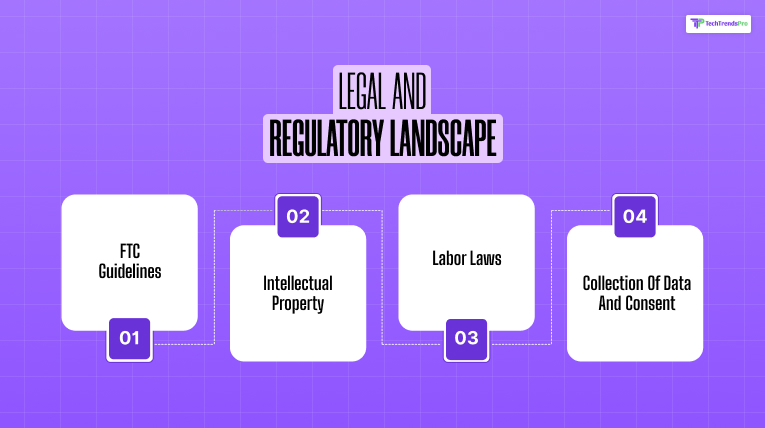
There is a gray area of the law surrounding the existence of AI influencers.
- FTC guidelines stipulate sponsored content disclosures within influencer posts. How does one work with AI?
- Intellectual property: Who owns the rights over the AI content?
- Labor laws: Would AI substitute traditionally filled slots by real actors or models?
- Collection of data and consent: For what purpose are the data of the users utilized in AI-generated content?
With the increase in land area, the regulatory bodies will have to establish AI-specific guidelines so that ethical consumer protection and advertising are ensured.
The Future Of AI Influencers
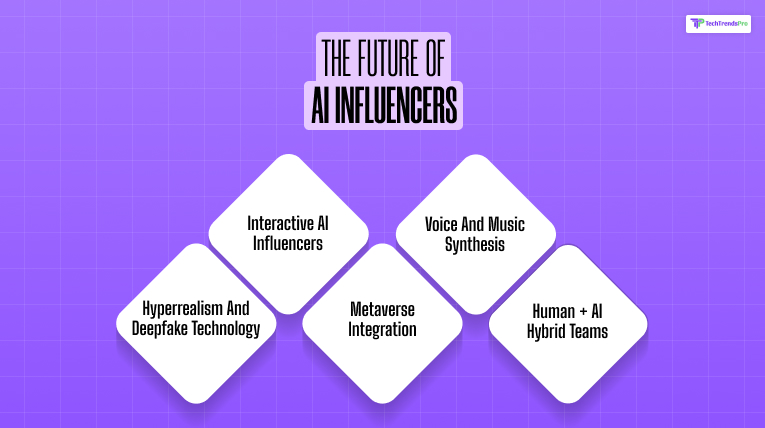
Where does the future of AI Influencers stand? Let’s find out.
1. Hyperrealism And Deepfake Technology
Technological advancement in the production of AI videos would render influencers virtually indistinguishable from human influencers.
2. Interactive AI Influencers
Future-generation influencers would be able to communicate with fans in real time and turn them into virtual buddies.
3. Metaverse Integration
AI influencers will have stable presences across a few virtual realms, attending events, conducting programs, or performing music.
4. Voice and Music Synthesis
Get ready for AI influencers to release full albums or podcasts using synthesized voices.
5. Human + AI Hybrid Teams
Some will be hybrids—AI personalities with human creators or actors (virtual representations of actual people).
Influencers created by AI are reshaping social media, advertising, and online identity. They raise fascinating questions regarding the influence, the creativity, or being “real.”
While the creative and control benefits are invaluable, the psychological and ethical dimensions cannot be ignored.
As such, artificial stars keep blurring digital borders; the future of influence will probably be one where humans and AI coexist, sometimes competing, sometimes conflicting, but always changing.
Additional Resources:






